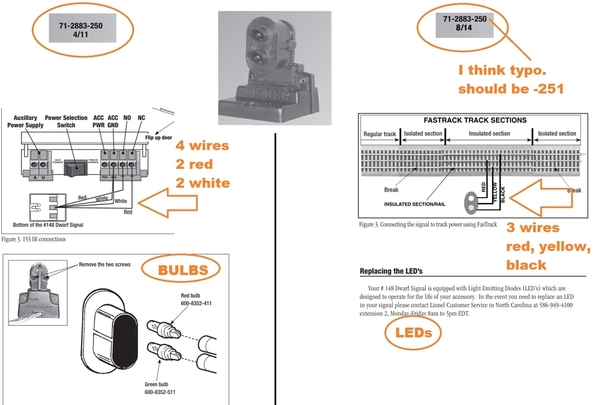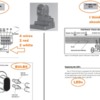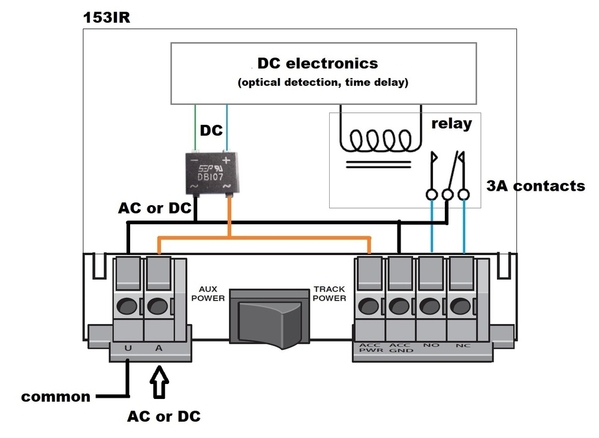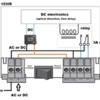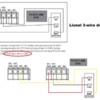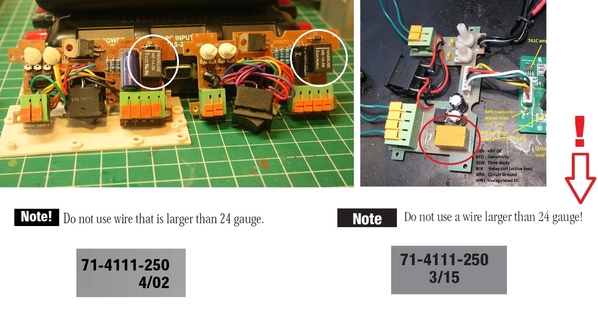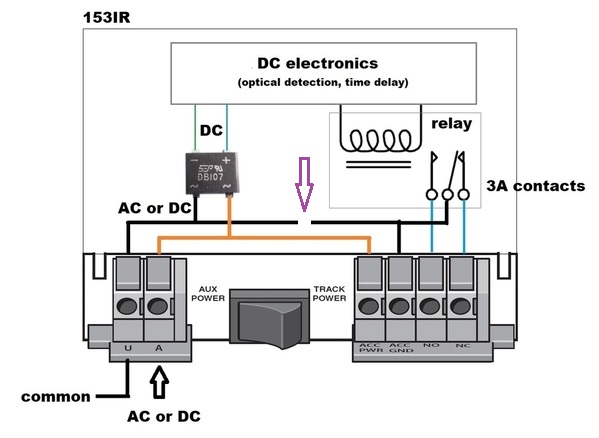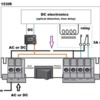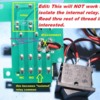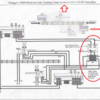I would like to wire (1) dwarf signal to a pair of 153IR's that will be located on my main line approximately 30 feet from each other using track power. The dwarf signal will be located at the exit/entrance of the yard. Is it possible to wire the (2) 153IR's to just a single signal? If a train passes by one sensor and crosses the next sensor before timing out will it damage the signal or 153IR's? I was hoping not to have to install a relay if possible.
Replies sorted oldest to newest
Exactly which dwarf signal do you have?
Right. This is a classic conundrum. The 148 has two inputs - green and red. The 153IR has two outputs - green and red. If you have two 153IR's what happens if they send conflicting commands.
How are you powering the 153IRs and 148s?
Do you have some spare 148 bulbs lying around?
Attachments
I plan on using track power. I have some universal Evans bulbs laying around.
I may be getting ahead of myself. Which version of the 148 do you have?
I don't have a 148. As contrasted above using the miracle of cut-and-paste, Lionel has (at least) 2 versions of the 148. The -250 version is older (2011) and has incandescent bulbs for the lamps. The -251 version is newer (2014) and has LEDs for the lamps. Presumably you've turned them on and might recognize an incandescent bulb vs. an LED...or it appears from the manuals that you can distinguish by whether there are 4 wires or 3 wires coming out the signal.
Attachments
I have the older version with the incandescent bulbs. If I can find the newer (or another "LED" brand) ones I will order them since they are cooler and draw less power.
I like your thinking.
So if you have the newer LED version, life becomes so much simpler. That is, the LED version has only a single input to flip the signal to red (whereas the bulb version has dual inputs).
With a single input, you can simply tie together the two "N.O." outputs of your two 153IR's and the signal will flip to red when either OR both of the 153IR's is triggered. The "N.C." outputs of the 153IR's are not used. There is NO electrical "conflict" if the 2 153IR's disagree on occupancy.
For background, where I was going if you had the incandescent bulb version is as follows. There is a "trick" where you can use some spare incandescent bulbs (but not the Evans universal bulbs) to convert the 2-input signal into a 1-input signal. It has its limitations but does work and has been around for decades.
I am happy that you see the wisdom of going to the low-power LED version even if not realizing how this makes it so much easier to apply with dual 153IR's.
Stan is correct, i have 4 that control two crossing gates. Just a word of caution, there are two of the 153s out there, not including the new one. They need to be wired differently. Stan helped me with a diagram of the difference.
Stan,
I was searching for a diagram of the newer LED version but I can't seem to find one. The older incandescent version that I have has 4 wires. Does the newer version have only 2 wires?
@Tony H posted:Stan is correct, i have 4 that control two crossing gates. Just a word of caution, there are two of the 153s out there, not including the new one. They need to be wired differently. Stan helped me with a diagram of the difference.
Tony,
What is the difference between the 3 models?
I can’t speak of the new one, but here is a post that shows the difference on the two older ones.
Tony,
I will have to see what version I have. I do know they are more than 5 years old, probably closer to 10 years old not positive though.
@R Whitley posted:Stan,
I was searching for a diagram of the newer LED version but I can't seem to find one. The older incandescent version that I have has 4 wires. Does the newer version have only 2 wires?
From what I can tell, the LED version has 3 wires. See the right side of the most recent diagram above. On the Lionel website for the same SKU/model # there are 2 different "reference numbers". Of course you order an item by the SKU number and I don't think you can specify the reference number.
I don't know how the following photo is rendered on your screen but the following is an LED version which is what you want (it has the 3 wire connection). From what I can tell, the LED version will have a yellowish tint to the green lamp. It appears Lionel did not use a pure/deep green as you might be familiar with from a traditional green bulb. Yeah, it's nit-picking on my part and OK I need to "get a life" but the pure/deep green LEDs are just a couple pennies more.
So I guess if ordering from a distributor you can ask how many wires are there...or if the Reference number with the -251 suffix is on the box or whatever.
What Tony is referring to is a separate rabbit hole! Lionel did the same thing with the 153IR. There are (at least) two versions of the 153IR that have different wiring instructions! Yet, the different versions have the same SKU/model number...and most confusingly the same reference number! OK, I get this is a first-world-problem but still....![]()
I was figuring we can solve the 148 "problem" first. The 148 variations on a theme are new to me and I'm learning along with all you guys! OTOH I've been to the 153IR rodeo so I figure I can deal with that when the time comes. ![]()
Attachments
Stan,
I really thank you for all your help (and Tony) that's what I love about this forum, the kind folks, the knowledgeable folks and the willingness to help one another.
I do have one more question, that is where do the 3 wires land on the 153IR? I tried to open the manual on Lionel's site but could not for some reason.
I attached 3 PDF files of 3 "different" 153IR versions I just pulled off the Lionel site...from 2002, 2014, and 2015. IIRC the best way to determine which version of the 153IR you have is to look at the power input terminals on the left and note the orientation of U and A.
OTOH it appears the best way to determine which version of the 148 you have is to see if there are 3 or 4 wires (?) ![]()
Attachments
Correct. If you have the 3-wire version of the 148 with the single-wire trigger, you can have an unlimited number of 153IRs. If just one, any combination, or all of the 153IR's are triggered it will flip the dwarf to red.
Reading between the lines, it might take an experiment or two but even if you have a mix of different 153IR versions I believe it is still possible.
I will let you know how it turns out after my order comes in.
Thanks again!
Well in case it helps the attached .pdf circuit shows how I wired a pair of 153IR's back in 2008. This has worked flawlessly ever since. I apologize that it's hand drawn, but I think its easy enough to follow. This setup services two road crossings that are several feet apart on the same mainline track. One 135IR is to the left of the crossings; the other to the right. You will note there is a pair of ROWI 4 light cantilever signals, and a pair of RK 4 light crossbuck signals. Many other signal variations are possible.
The key thing to note is the 153IR's are wired parallel with respect to the relay Gnd, NC and NO connections. So they operate as two separate SPDT switches. When either one triggers, the NO contacts are grounded, and all signals at both crossings operate in unison. This same idea could be extended to one or two more 153IR's (connected the same way) on converging switch tracks say, or whatever. A key thing to know about the 153IR is that the relay is only rated at 2 amps. This is fine for any number of led devices, or a few incandescents, but no good for something like the gateman for instance. For any heavy load accessories you would want to use the 153IR's to activate a relay, which in turn operates the accessory. ![]()
Rod
Attachments
Rod,
Thanks for the drawing I appreciate that very much! In your example I see you are using a external power source, will this work with track power if the devices will handle the current?
@R Whitley posted:Rod,
Thanks for the drawing I appreciate that very much! In your example I see you are using a external power source, will this work with track power if the devices will handle the current?
I have never tried running them off track power but I suppose you could. I always use accessory power sources for anything other than running trains. Why wouldn't you use the accessory power tap from whatever transformer you are using?? ![]() Also I don't follow what you mean by ".....if the devices will handle the current?" What current do you mean? A device will only pull whatever current from the source that it needs to operate. That current is unrelated to the current that your trains need to operate. And the 153IR relays are only good for max 2 amps. What are you trying to actuate with your 153IR's?
Also I don't follow what you mean by ".....if the devices will handle the current?" What current do you mean? A device will only pull whatever current from the source that it needs to operate. That current is unrelated to the current that your trains need to operate. And the 153IR relays are only good for max 2 amps. What are you trying to actuate with your 153IR's?
Rod
My apologies, I went back in the thread and I see you want to operate a dwarf led signal. So the 2 amp relay rating will be way more than you need. All good.
I should also point out that the 153IRs I am using are first generation 2002, so the connections for yours may be different. Regardless, the concept is the same, wire the relay connectons in parrallel between the two 153IRs and all should be well in the kingdom. ![]()
Rod
@R Whitley posted:Stan,
I have some Lionel #148 Dwarf Signals 6-12883 laying around. I'm open to changing to something that may work better.
Not sure if this would work for you, but here's a simple schematic using a Z-Stuff block signal detector and relay to an MTH dwarf signal.

In the previous thread, that Tony H referenced, it looks like Stan has opened one of these up. I am curious about the internal connections, especially for the relay.
Dave
I made the above diagram for the 153IR I dis-assembled. I have yet to find a definitive marking, stamp, labeling, or whatever to know for certain which version I had. Perhaps obvious when drawn out, but the key is the two power inputs (whether from track power or Aux power) are wired over to the 4 terminals that go to the accessory; and that one of the two power wires is internally wired to the common of the relay.
In the latest online 153IR manual the diagram for the Lionel Dwarf is as shown:
Note how the caption specifically mentions "2014" suggesting there are other versions of the 148 dwarf that would be wired differently! To be absolutely clear this diagram is for the LIONEL 3-wire dwarf. The earlier post by Richie C shows a MTH 3-wire dwarf. THEY ARE NOT WIRED THE SAME WAY. As his diagram shows the MTH 3-wire dwarf requires a RELAY.
In any case, getting back to the original problem. Once the LIONEL 3-wire dwarfs are in hand, it won't take long to sort out versions of the 153IR. It will be handy to have a multimeter that measures Ohms (resistance).
Then, connecting the 2nd 153IR to work in tandem will be as simple as connecting 1 wire between the N.O. terminals of the 2 153IRs! Life should be so easy! ![]()
Attachments
Stan, perhaps I should have been a bit more clear. I was asking about the actual connections for the relay, whether it is soldered directly to the board, or wired like the toggle switch appears to be in your pictures from the other thread.
Dave
@Dtrainmaster posted:Stan, perhaps I should have been a bit more clear. I was asking about the actual connections for the relay, whether it is soldered directly to the board, or wired like the toggle switch appears to be in your pictures from the other thread.
Soldered directly to the single-side PCB with thru-hole relay terminals. I found this photo showing 2 versions of the 153IR which I must have posted in a previous OGR thread but can't remember the context - probably a discussion about how to replace a potentially broken relay or something like that.
Attachments
Thanks Stan. Do you think that the connection or trace between the relay's common terminal and either the A or U terminal (depending on the version) can be easily accessed and opened?
Attachments
Edit: this will NOT work; a different solution shown later in thread. I leave the photo and comments for continuity of discussion...
In the above case all you'd have to do is de-solder the black wire where shown. Then, the left 3 (per photo above) externally accessible terminals on the 153IR would be "relay NC" "relay NO" and "relay COM" and you would be free to have the relay control whatever you want!
I don't know how many variants of the 153IR PCB there are, but I suspect that in some variants you might have to cut a fat PCB trace with an X-acto knife to break the connection between the internal relay's "common" and train power. But in any case I think you could always end up with 3 terminals that represent completely "isolated" NC-NO-COM so you are electrically divorced from only controlling train power.
Great question!!! ![]()
Attachments
Thanks Stan for checking the board. That's what I was hoping for, an easy alteration for most.
I have an application drawing made but need to finalize a few things on it.
Dave
@Dtrainmaster posted:153 IR modification
...
This modification enables 2-aspect signals to change from GRN to RED whenever any detector in the string is triggered....
Perhaps just a note to myself for when I stumble on this thread in the future...but what Dtrainmaster is showing is a method to drive the 4-wire 148 dwarf signal. Yes, it does require mucking around inside the 153IR which is not in most folks' comfort zone. And without getting into the details, I did study some photos of earlier versions of the 153IR and the mucking around is a bit more involved.
Also this modification can be used to good effect for two (or more) 153IRs controlling the 5-wire crossing gates (Lionel or MTH). If using two Lionel 153IRs or two MTH ITADs to control the 5-wire crossing gate, you need an external relay. For example, Lionel has a somewhat complicated diagram showing how to wire the external relay. Arguably, by the time you procure parts, pull hair out trying to follow the Lionel diagram, etc. what Dtrainmaster shows is the superior solution! No external relay required! Zero out-of-pocket expense! Wow, I could have had a V8! ![]()
Attachments
Seems a lot of work to avoid a simple relay...
Nothing is so easy as the job you imagine someone else doing!
1. Lionel's diagram suggests Radio Shack components. In 2021 how many guys have access to Radio Shack - even the re-incarnated Hobby Lobby variant?
2. The suggested bridge-rectifier is not even sold at RadioShack.com...and how many guys are comfortable choosing an alternative based on techno-mumbo-jumbo specifications?
3. The suggested relay IS still available at RadioShack but is a whopping $14.99...and you still need to buy a relay socket or solder to the spade-lugs. Again, how many guys are comfortable choosing an alternative...is it a problem that the Lionel diagram says 15 Amp contacts, but the Radio Shack listing says that part number has 10 Amp contacts? And aren't these Amp ratings a bit over the top for the application at hand?
4. Then you look at the Lionel diagram and see a box representing a relay with 6 terminals labeled COM NO NC twice over. I don't know what the package on the Radio Shack relay looks like, but how many guys know that a dual-pole relay has separate COM NO and NC for each pole. Which COM to use? Can either NO be used? I don't think it's obvious how to hook up the terminals of the relay just looking at the diagram.
5. And so on. ![]()
OTOH, the out-of-pocket cost for the workaround is $0 (as in zero). In the case of the modern 153IR the modification does not even require a soldering iron! Just clip 1 wire. Yes, you do have to remove some screws to open up the 153IR so there is that.
I'm just thankful for OGR that we have a venue to have these discussions! 
@stan2004 posted:I made the above diagram for the 153IR I dis-assembled. I have yet to find a definitive marking, stamp, labeling, or whatever to know for certain which version I had. Perhaps obvious when drawn out, but the key is the two power inputs (whether from track power or Aux power) are wired over to the 4 terminals that go to the accessory; and that one of the two power wires is internally wired to the common of the relay.
In the latest online 153IR manual the diagram for the Lionel Dwarf is as shown:
Note how the caption specifically mentions "2014" suggesting there are other versions of the 148 dwarf that would be wired differently! To be absolutely clear this diagram is for the LIONEL 3-wire dwarf. The earlier post by Richie C shows a MTH 3-wire dwarf. THEY ARE NOT WIRED THE SAME WAY. As his diagram shows the MTH 3-wire dwarf requires a RELAY.
In any case, getting back to the original problem. Once the LIONEL 3-wire dwarfs are in hand, it won't take long to sort out versions of the 153IR. It will be handy to have a multimeter that measures Ohms (resistance).
Then, connecting the 2nd 153IR to work in tandem will be as simple as connecting 1 wire between the N.O. terminals of the 2 153IRs! Life should be so easy!
Stan, I just received my 3 wire LED Lionel dwarfs 6-12883 from Charles Ro and by the way they are great folks to deal with. With the diagram above I wired (4) 153IR's with the jumper going in and out on the N/O contacts. I just had (1) dwarf wired to (1) 153IR and a jumper leaving that one and in and out on the next (3) 153IR's. Worked Great!
I happen to have a police vehicle with LED's attached to the 4th 153IR on N/O contacts and those lights also operated when I tripped any one of the 153IR's.
I didn't try to put the car on the N/C contacts, I wonder if the jumper going to the N/O contacts would change that to N/O or would it effect that function at all. What's your thoughts on that?
Mission Accomplished!
@R Whitley posted:Stan, I just received my 3 wire LED Lionel dwarfs 6-12883 from Charles Ro and by the way they are great folks to deal with. With the diagram above I wired (4) 153IR's with the jumper going in and out on the N/O contacts. I just had (1) dwarf wired to (1) 153IR and a jumper leaving that one and in and out on the next (3) 153IR's. Worked Great!
I happen to have a police vehicle with LED's attached to the 4th 153IR on N/O contacts and those lights also operated when I tripped any one of the 153IR's.
I didn't try to put the car on the N/C contacts, I wonder if the jumper going to the N/O contacts would change that to N/O or would it effect that function at all. What's your thoughts on that?
Mission Accomplished!
wow, that was fast. ![]()
Summarizing: you have 4 153IRs. The N/O contacts on all 4 are connected/daisy-chained together. The police car is connected to this "communal" N/O bus and the police car operates whenever one (or more) 153IR trips.
The N/C contacts on the 4 153IRs are presently un-connected. If you connect the police car to the N/C of one of the 4, the police lights will normally be ON, and turn OFF when that particular 153IR is tripped. Not sure if you're asking about daisy-chaining the N/C terminals from ALL of the 4 153IRs? I don't think that would be a useful configuration. That is, in such a case the police car would only turn OFF when all 4 of the 153IRs are tripped which one would think would be a once-in-a-blue-moon occurrence?
@stan2004 posted:wow, that was fast.
Summarizing: you have 4 153IRs. The N/O contacts on all 4 are connected/daisy-chained together. The police car is connected to this "communal" N/O bus and the police car operates whenever one (or more) 153IR trips.
The N/C contacts on the 4 153IRs are presently un-connected. If you connect the police car to the N/C of one of the 4, the police lights will normally be ON, and turn OFF when that particular 153IR is tripped. Not sure if you're asking about daisy-chaining the N/C terminals from ALL of the 4 153IRs? I don't think that would be a useful configuration. That is, in such a case the police car would only turn OFF when all 4 of the 153IRs are tripped which one would think would be a once-in-a-blue-moon occurrence?
Stan, I don't want to daisy chain the N/C, but I would like to keep the police car tied into that one 153IR. I may even tie something else to the other (3) 153IR's like other cars or some other low amperage draw accessories. So, does that daisy chain connection affect both the N/O and N/C on all the 153IR's contacts when anyone of the 4 are tripped?
The daisy-chain does NOT decrease the amperage capability. This applies to N/O and/or N/C. So you can daisy-chain all the N/O without affecting the N/C (4 isolated N/C or all 4 daisy-chained).
Lionel has changed the relay used in the 153IR over time, but I noted in an earlier diagram that the contacts on a modern 153IR are rated at 3 Amps. I'd have to check but even the earliest versions had contacts of at least 1 Amp. Your 3-wire Lionel dwarf LED signal requires not even 1% of that capability!
Let there be light!
If I'm understanding you correctly, I can put another dwarf signal or another device on any one of the other units that are daisy chained on the N/C contacts and that 153IR would operate totally independent of the other ones?
@R Whitley posted:If I'm understanding you correctly, I can put another dwarf signal or another device on any one of the other units that are daisy chained on the N/C contacts and that 153IR would operate totally independent of the other ones?
To be clear, your 4 units are daisy-chained on the N/O contacts...and now you are putting another dwarf signal or another device on the N/C contact of 1 of the 4 153IRs?
The 3-wire Lionel LED dwarf operates backwards if connected to the N/C contact of 1 of 4 the 153IRs. So signal will be RED when un-occupied...and turn GREEN when occupied (tripped). Or if the device is a lighted police car, as mentioned above, it would be ON when that particular 153IR is un-occupied and turn OFF when that 153IR is occupied (tripped).
I guess it's a question of semantics to say "that" 153IR operates totally independent. Since its N/O contact is still daisy-chained to the other 153IRs, it (or any of the other 3) will turn the original dwarf RED when it (or any of the other 3) is tripped.






